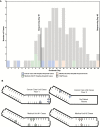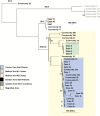Prospective, Real-time Metagenomic Sequencing During Norovirus Outbreak Reveals Discrete Transmission Clusters
- PMID: 30576430
- PMCID: PMC6735836
- DOI: 10.1093/cid/ciy1020
Prospective, Real-time Metagenomic Sequencing During Norovirus Outbreak Reveals Discrete Transmission Clusters
Abstract
Background: Norovirus outbreaks in hospital settings are a common challenge for infection prevention teams. Given the high burden of norovirus in most communities, it can be difficult to distinguish between ongoing in-hospital transmission of the virus and new introductions from the community, and it is challenging to understand the long-term impacts of outbreak-associated viruses within medical systems using traditional epidemiological approaches alone.
Methods: Real-time metagenomic sequencing during an ongoing norovirus outbreak associated with a retrospective cohort study.
Results: We describe a hospital-associated norovirus outbreak that affected 13 patients over a 27-day period in a large, tertiary, pediatric hospital. The outbreak was chronologically associated with a spike in self-reported gastrointestinal symptoms among staff. Real-time metagenomic next-generation sequencing (mNGS) of norovirus genomes demonstrated that 10 chronologically overlapping, hospital-acquired norovirus cases were partitioned into 3 discrete transmission clusters. Sequencing data also revealed close genetic relationships between some hospital-acquired and some community-acquired cases. Finally, this data was used to demonstrate chronic viral shedding by an immunocompromised, hospital-acquired case patient. An analysis of serial samples from this patient provided novel insights into the evolution of norovirus within an immunocompromised host.
Conclusions: This study documents one of the first applications of real-time mNGS during a hospital-associated viral outbreak. Given its demonstrated ability to detect transmission patterns within outbreaks and elucidate the long-term impacts of outbreak-associated viral strains on patients and medical systems, mNGS constitutes a powerful resource to help infection control teams understand, prevent, and respond to viral outbreaks.
Keywords: hospital epidemiology; infection prevention; metagenomic next generation sequencing; norovirus; outbreak.
© The Author(s) 2018. Published by Oxford University Press for the Infectious Diseases Society of America.
Figures



Similar articles
-
Rapid detection of a norovirus pseudo-outbreak by using real-time sequence based information.J Clin Virol. 2013 Sep;58(1):245-8. doi: 10.1016/j.jcv.2013.06.034. Epub 2013 Jul 20. J Clin Virol. 2013. PMID: 23880160
-
Next-generation whole genome sequencing identifies the direction of norovirus transmission in linked patients.Clin Infect Dis. 2013 Aug;57(3):407-14. doi: 10.1093/cid/cit287. Epub 2013 May 3. Clin Infect Dis. 2013. PMID: 23645848 Free PMC article.
-
Epidemiological investigation of a norovirus GII.4 Sydney outbreak in a China elder care facility.Jpn J Infect Dis. 2015;68(1):70-4. doi: 10.7883/yoken.JJID.2014.081. Jpn J Infect Dis. 2015. PMID: 25702790
-
[Norovirus infections: an overview].Med Sci (Paris). 2010 Jan;26(1):73-8. doi: 10.1051/medsci/201026173. Med Sci (Paris). 2010. PMID: 20132778 Review. French.
-
Human norovirus transmission and evolution in a changing world.Nat Rev Microbiol. 2016 Jul;14(7):421-33. doi: 10.1038/nrmicro.2016.48. Epub 2016 May 23. Nat Rev Microbiol. 2016. PMID: 27211790 Review.
Cited by
-
INTRA- AND INTER-HOST EVOLUTION OF HUMAN NOROVIRUS IN HEALTHY ADULTS.bioRxiv [Preprint]. 2024 Sep 5:2023.05.30.542907. doi: 10.1101/2023.05.30.542907. bioRxiv. 2024. PMID: 39282326 Free PMC article. Preprint.
-
The clinical value of metagenomic next-generation sequencing for rapid microbial identification of chronic granulation wound infections.Arch Med Sci. 2023 Jul 13;19(4):1162-1167. doi: 10.5114/aoms/166255. eCollection 2023. Arch Med Sci. 2023. PMID: 37560730 Free PMC article. No abstract available.
-
High Throughput Sequencing for the Detection and Characterization of RNA Viruses.Front Microbiol. 2021 Feb 22;12:621719. doi: 10.3389/fmicb.2021.621719. eCollection 2021. Front Microbiol. 2021. PMID: 33692767 Free PMC article. Review.
-
NGSocomial Infections: High-Resolution Views of Hospital-Acquired Infections Through Genomic Epidemiology.J Pediatric Infect Dis Soc. 2021 Dec 24;10(Supplement_4):S88-S95. doi: 10.1093/jpids/piab074. J Pediatric Infect Dis Soc. 2021. PMID: 34951469 Free PMC article. Review.
-
Using molecular methods to delineate norovirus outbreaks: a systematic review.Arch Virol. 2024 Jan 3;169(1):16. doi: 10.1007/s00705-023-05953-w. Arch Virol. 2024. PMID: 38172375
References
-
- Teunis PF, Moe CL, Liu P, et al. Norwalk virus: how infectious is it? J Med Virol 2008; 80:1468–76. - PubMed
-
- Morter S, Bennet G, Fish J, et al. Norovirus in the hospital setting: virus introduction and spread within the hospital environment. J Hosp Infect 2011; 77:106–12. - PubMed
-
- Ludwig A, Adams O, Laws HJ, Schroten H, Tenenbaum T. Quantitative detection of norovirus excretion in pediatric patients with cancer and prolonged gastroenteritis and shedding of norovirus. J Med Virol 2008; 80:1461–7. - PubMed
Publication types
MeSH terms
Grants and funding
LinkOut - more resources
Full Text Sources
Medical
Molecular Biology Databases

